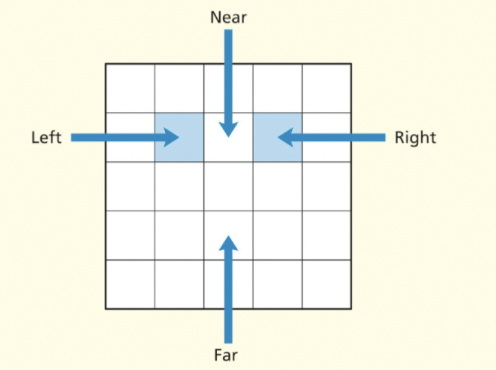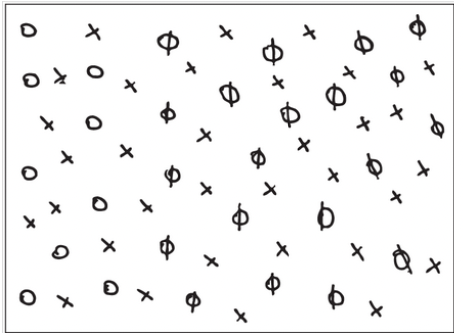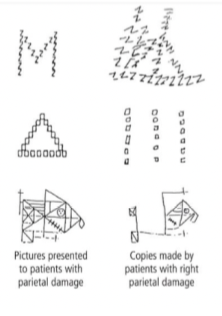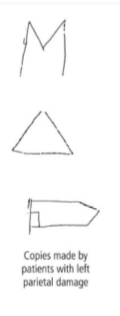Lecture 4- Attention bottlenecks
1/71
There's no tags or description
Looks like no tags are added yet.
Name | Mastery | Learn | Test | Matching | Spaced |
|---|
No study sessions yet.
72 Terms
In human information processing, what are serial bottlenecks?
The filter points at which it is no longer possible to process incoming perceptual information (e.g. song, light smell) from our senses simultaneously
When we're no longer able to process a lot of information at once
At which point does this occur?
What do early selection theories say about information processing?
Theories of attention proposing that the selection of information occurs early in information processing
What do late selection theories say about information processing?
Theories of attention proposing that the selection of information occurs late in information processing
Load theory (Lavie, 2005, 2010) distinguishes between…?
Perceptual and cognitive load (perceptual demands of the task vs. burden placed on the cognitive system by the current task)
High perceptual load is associated with low distractibility whereas high cognitive load is associated with high distractibility
According to load theory, brain activation associated with distractors should be less when…?
Individuals are performing a task in involving high perceptual load
Found with visual tasks and distractors and with auditory tasks and distractors
Load theory- what did Burnham et al. (2014) find in terms of distraction effects?
Distraction effects on a visual search task were greater when participants performed another task placing high demands on the cognitive system (greater when cognitive or working memory load is high)
Load theory assumes the effects of perceptual and cognitive load are independent. However, Linnell and Caparos (2011) found…?
Perceptual and cognitive processes interacted
Perceptual load only influenced attention as predicted when cognitive load was low
Effects of perceptual load are not automatic but depend on cognitive resources being available
Give 2 limitations of load theory
The terms 'perceptual load' and 'cognitive load' are vague, making it hard to test the theory
The prediction that high cognitive load is associated with high distractibility has been disproved when the task and distracting stimuli are easily distinguishable
What is the cocktail party phenomenon (Cherry, 1953)?
How can we follow just one conversation when several people are talking at the same time?
McDermott identified two problems listeners face when attending to one voice among many. What are they?
Sound segregation; deciding which sounds belong together
Directing attention to the sound source of interest and ignoring the others
Various top-down factors based on listeners' knowledge and/or expectations are involved in early auditory processing. Give an example
Listeners are more accurate at identifying what one speaker is saying (in the context of other speakers) if they have previously heard that speakers voice in isolation- McDermott (2009)
Cocktail party phenomenon- what did Shamma et al. (2011) find in terms of distinctive features?
If listeners can identify one distinctive feature of the target voice, they can distinguish its other sound features via temporal coherence
Cocktail party phenomenon- what did Golumbic et al. (2013) find in terms of visual information?
Processing of the attended message was enhanced when listeners saw a video of the speaker talking
Individuals can also use visual information to assist them in understanding what a given speaker is saying
Describe the procedure of the dichotic listening task
Participants wear a set of headphones
Then hear two messages simultaneously (one in each ear)
One is relevant, one is not
Participants must 'shadow' (repeating back the message from one ear) the relevant channel and ignore the irrelevant information from the other
After the experiment, ask questions about the channel they should have blocked
Seeing what they noticed in that message
Give a limitation of the dichotic listening task
However, listeners don't normally engage in shadowing so the task is artificial and it increases listeners' processing demands
Dichotic listening task- what do participants fail to notice in the unattended message?
Semantic features like..
Message played backwards
Several words repetitions
Message played in a foreign language
Dichotic listening task- what do participants notice in the unattended message?
Physical features like…
Male or female speaker
Speech changing from male to female speaker
Whether it was a human voice or just noise
What does the dichotic listening task tell us about the selection of information?
Semantic features (about the meaning) were not noticed but some physical features were
Seems like the selection of information was mostly based on physical features and not semantic features
What does Broadbent’s (1958) filter theory say about information selection?
Sensory information comes through the system until it reaches a bottleneck
Information can be selected based on a physical selection criterion (e.g. ear or pitch)
The person filters out the information based on physical characteristics/features
The information we choose to select continues to be processed, but for the other information it's completed blocked
Filter theory- what were the methods in Moray’s (1959) study?
A dichotic listening task;
What happens when we introduce the name of the participant in the non-shadowed ear (irrelevant channel)?
Filter theory- what were the findings in Moray’s (1959) study?
33% of the participants detect their name (semantic characteristics)
Seems to challenge Broadbent's filter theory
According to this theory this wouldn't be possible
Filter theory- what were the methods in Gray and Wedderburn’s (1960) study?
A dichotic listening task
Message 1; string of numbers
Message 2; meaningful sentence
Alternated the ear to which words in a meaningful sentence was played
Filter theory- what were the findings in Gray and Wedderburn’s (1960) study?
When asked to report what they listened to, participants would have no problems in reporting the meaningful sentence correctly
According to Broadbent, participants shouldn't have been able to do this at all
What does Gray and Wedderburn’s (1960) study suggest?
Results suggest that participants can alternate between channels (select information) based on the semantic properties of the stimuli
The finding proposed a problem to the early selection theory of auditory attention (filter theory)
Filter theory- what were the methods in Treisman’s (1960) study?
A dichotic listening task
Meaningful message in one ear and meaningless in the other
The meaningful message is switched to the other ear (non-shadowed ear)
Filter theory- what were the findings in Treisman’s (1960) study?
Some participants switch ears and keep shadowing meaningful message, breaking the instruction
Some others keep attending the message in the first ear
What does Treisman’s (1960) study suggest?
Results suggest that selection of information can be flexible
Participants can sometimes select information based on physical characteristics (e.g. a particular ear) and sometimes based on the semantic characteristics (e.g. meaning of the message)
Therefore another theory is needed to account for this flexible type of information selection
What does Treisman’s (1964) attenuation theory say about information selection?
Another type of early selection theory
Sensory information comes though the system until it reaches an attenuator
Information is attenuated (weakened), not filtered out
Information can be selected based on a semantic selection criterion (e.g. meaning of the message)
Why we can detect our name or some semantic information in some cases
Treisman also argued top-down processes (e.g. expectations) are important. Why did they think this?
Listeners performing the shadowing task sometimes say a word from the unattended input (mostly occurs when the word on the unattended channel is highly probable in the context of the attended message)
What does Deutsch and Deutsch’s (1963) late-selection theory say about information selection?
All information is processed completely (physical properties and meaning) without attenuation
The bottleneck (capacity limitation) is in the response system and not the perceptual system
Can only respond to a certain amount of information at once
Most important/relevant stimulus determines the response
Summarise what each theory says about unattended input
Broadbent; little/no processing of unattended auditory messages
Treisman; flexibility in the processing of unattended messages
Deutsch and Deutsch; reasonably thorough processing of such messages
What did Aydelott et al. (2015) find in terms of attended target words?
Performance on attended target words was enhanced when unattended words related in meaning were presented shortly before (meaning was processed)
Support for attenuation theory?
What did Li et al. (2011) find in terms of words with a special significance?
Often more processing of unattended words that have a special significance for the listener
Unattended weight related words (e.g. fat) were processed more thoroughly by women dissatisfied with their weight
What did Coch et al. (2005) find in terms of auditory inputs and ERPs?
Asked listeners to attend to one of two auditory inputs and to detect targets presented on either input
ERPs as a measure of processing activity
ERPs 100ms after target presentation were greater when the target was presented on the attended message
More processing of the attended targets
What was the research question in Wood and Cowan’s (1995) study?
Which of the three theories is correct?
Filter theory, attenuation theory, or late-selection theory?
What were the methods in Wood and Cowan’s (1995) study?
Dichotic listening task;
Introduce participants' name in the irrelevant channel
Monitor the percent of shadowing errors
Wood and Cowan- what would happen if filter theory was correct?
Participants should only detect their name if their attention has wandered in the irrelevant channel (not doing the task properly)
Would expect participants to be unable to process semantic information
Prediction; more shadowing errors before the presentation of the name

Wood and Cowan- what would happen if attenuation theory was correct?
The name should activate the appropriate lexical unit in memory only weakly (low signal initially but slow increase in understanding)
Detect a low signal, takes some time as the information is attenuated- participants then think they're talking about them so switch to the other ear to hear what's being said
Prediction; more shadowing errors after the presentation of the name

Wood and Cowan- what would happen if late-selection theory was correct?
Participants would detect their name routinely (all information is processed fully, immediately go to the wrong ear)
Would hear their name in the irrelevant channel very clearly and loudly
Prediction; more shadowing errors during the presentation of the name

What were the findings in Wood and Cowan’s (1995) study? Which theory seems to be correct?
34.6% of the participants recall hearing their name in the channel to be ignored
More shadowing error after the presentation of the name
These results support attenuation theory
What does Posner (1980) say about visual attention?
Visual attention is like a spotlight
Illuminates a fairly small area, little can be seen outside is beam and it can be redirected to focus on any given object
What do Eriksen and St. James (1986) say about visual attention?
Attention is more flexible
More like a zoom lens- can increase or decrease the area of focal attention
E.g. car drivers narrowing attention after spotting a potential hazard
Attention as a zoom lens- what were the methods in Muller et al.’s (2003) study?
Observers saw 4 squares in a semi circle and cued to attend to one, two or all four
4 objects presented (one in each square)
Observers decided whether a target (e.g. a white circle) was among them
Attention as a zoom lens- what were the findings in Muller et al.’s (2003) study?
Performance was best with the smallest attended region and worst with the largest (as predicted by the zoom lens theory)
Attention as a zoom lens- what were the methods in Goodhew et al.’s (2016) study?
Focused on temporal perception- was a disc presented continuously or were there two presentations separated by a brief interval?
Attention as a zoom lens- what were the findings in Goodhew et al.’s (2016) study?
Spotlight size had no effect on temporal acuity, which is inconsistent with the theory
Spatial resolution is poor in peripheral vision, whereas temporal resolution is good
A small attentional spotlight is more beneficial for spatial than temporal acuity
What do Awh and Pashler (2000) say about visual attention?
Attention is more like multiple spotlights
Sometimes exhibit split attention- directed to two or more non-adjacent regions in space
Attention as multiple spotlights- what were the methods in Awh and Pashler’s (2000) study?
Identifying two digits presented to two cued locations a little way apart
On some trials a digit was presented between the two cued locations

Attention as multiple spotlights- what were the findings in Awh and Pashler’s (2000) study?
According to zoom-lens theory, the area of maximal attention should include the two cued locations and the space in between
However, found that detection of the digits presented in the middle was poor
Support for the split attention approach
What is a limitation of all 3 visual attention theories?
Metaphors (e.g. attention is a zoom lens) are used to describe experimental findings but they fail to specify the underlying mechanisms (Di Lollo, 2018)
Describe the procedure of Neisser and Becklen’s (1975) visual shadowing task
Participants watched superimposed videotapes (hands clapping and people passing a ball to each other)
Instructed to pay attention to one of the two films and watch for odd events (e.g. shaking hands)
Describe the results of Neisser and Becklen’s (1975) visual shadowing task
When asked to monitor both films for odd events, ppts experienced great difficulty and missed many of the critical events
We can also filter visual information
Seems like there's a limited amount of visual information we can process at once (similar to auditory information)
What is intentional blindness?
Refers to the phenomenon in which we are unaware (unable to detect) what is happening in our direct field of view if we are not paying attention to it
Describe the procedure of Mack and Rock’s (1998) intentional blindness study
5000 ppts perform a perceptual task in which they judged whether the horizontal or vertical bar of a cross was longer (boring task)
After a number of trials, there would be a surprise trial in which an additional stimulus such as a rectangle would appear on the screen along with the cross
Stimulus only shown for 200ms
Describe the results of Mack and Rock’s (1998) intentional blindness study
Ppts were more likely to detect their surprise stimuli if it was their name (consistent with the cocktail party phenomenon)
Can process some semantic information from the non-relevant task
Describe the procedure of Simons and Chabris’ (1999) intentional blindness study
Ppts are asked to watch a video with two teams (black and white)
Must either count the number of passes from the black or white team
In the middle of the game, a person in a black gorilla suit walks through the room
Describe the results of Simons and Chabris’ (1999) intentional blindness study
Almost all participants fail to notice the gorilla when tracking the team in white (92% fail)
How do we process information in the visual field?
Information about the left side of the visual field goes to the right brain (and vice versa)
Process visual information contralaterally in the brain
What is visual neglect?
Absence of awareness of stimuli presented to the opposite side of the brain damage (contra-lesional side)
Most neglect patients have damage in the right hemisphere (lack of awareness of stimuli in the left visual field)
The right hemisphere is also dominant in spatial attention in healthy individuals
What kinds of tasks help us detect this damage (neglect)?
Sacks (1985)
The task was to put slashes through all circles (right hemisphere damage)
What happens to the circles in the left part of the visual field?

What is space-based or egocentric neglect?
Lack awareness of stimuli on the left side of the visual field
What is object-based or allocentric neglect?
Lack of awareness of the left side of objects
What is seen with damage to the right parietal lobe?
The right parietal lobe is more important in the spatial allocation of attention (directing our attention)
Important for global features
Able to reproduce specific features of the pictures but not global features

What is seen with damage to the left parietal lobe?
The left parietal lobe is important for specific features
Able to reproduce global features of the pictures but not specific features

What is extinction in neglect patients?
Involves a failure to detect a stimulus presented to the side opposite the brain damage when a second stimulus is presented to the same side as the brain damage
What did Molenberghs et al. (2012) find in terms of what brain areas are damaged in neglect patients?
Meta-analysis
Found the main areas damaged are in the right hemisphere
Nearly all the areas are within the ventral attention network, suggesting brain networks are damaged rather than simply specific brain areas
However heterogenous condition- brain areas damaged vary considerably across patients
What is typically seen in neglect patients in terms of conscious awareness and processing?
Neglect patients generally report no conscious awareness of stimuli presented to the left visual field
Doesn't mean they're not processed
Conscious awareness and processing- what did Vuilleumier et al. (2002b) find?
Presented extinction patients with two pictures at the same time, one to each visual field
Showed very little memory for left-field stimuli, however demonstrated a facilitation effect for left-field pictures when identifying degraded pictures
Suggests they had been processed to some extent
Conscious awareness and processing- what did Sarri et al. (2010) find?
Found extinction patients had no awareness of left field stimuli
However, these stimuli were associated with activation in early visual processing areas, indicating they received some processing
What did Corbetta and Shulman (2011) find in terms of networks damaged in neglect patients?
The bottom-up ventral attention network is damaged in patients with neglect
Also assumed that damage to the ventral network impairs the functioning of the goal-directed dorsal attention network (even though it's not damaged itself)
This is due to the interaction between the two networks
Research into neglect has produced several important findings. Give 3 examples
Neglect and extinction patients can process unattended visual stimuli in the absence of conscious awareness of those stimuli
Most neglect patients have damage to the ventral attention network leading to impaired functioning of the undamaged dorsal attention network
Extinction occurs because of biased competition for attention and reduced attentional capacity
Give 4 limitations of research into neglect
It is hard to produce theoretical accounts applicable to all neglect or extinction patients because the precise symptoms and regions of brain damage vary considerably across patients
Neglect patients vary in their precise processing deficits but this has been de-emphasised in most theories
The precise relationship between neglect and extinction remains unclear
The dorsal and ventral networks generally interact but the extent of their interactions remains to be determined